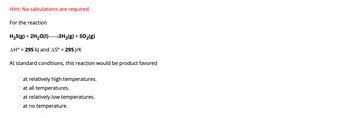
Chemistry
10th Edition
ISBN: 9781305957404
Author: Steven S. Zumdahl, Susan A. Zumdahl, Donald J. DeCoste
Publisher: Cengage Learning
expand_more
expand_more
format_list_bulleted
Question

Transcribed Image Text:Hint: No calculations are required.
For the reaction
H₂S(g) + 2H₂O(l)– →3H₂(g) + SO₂(g)
AH° = 295 kJ and AS° = 295 J/K
At standard conditions, this reaction would be product favored
at relatively high temperatures.
at all temperatures.
at relatively low temperatures.
O at no temperature.
OOO

Transcribed Image Text:Consider the reaction:
2BrF3(g)→→→→→→Br₂(g) + 3F₂(g)
Using standard thermodynamic data at 298K, calculate the entropy change for the surroundings when 2.27 moles of BrF3(g) react at
standard conditions.
ASS
surroundings
J/K
Expert Solution
This question has been solved!
Explore an expertly crafted, step-by-step solution for a thorough understanding of key concepts.
Step by stepSolved in 4 steps with 13 images

Knowledge Booster
Learn more about
Need a deep-dive on the concept behind this application? Look no further. Learn more about this topic, chemistry and related others by exploring similar questions and additional content below.Similar questions
- Consider the following reaction: H₂(g) + 12 (g) --> 2HI (g) Given the following data: H₂: AH° = 0 kJ/mol; Sº = 130 J/molk 12: AH°= 0 kJ/mol; Sº = 108 J/mol K HI: AH° = 26 kJ/mol; Sº = 201 J/mol K Determine the AGO in kJ for this reaction at 298K. Do not put units in your answer. Report your answer with two places past the decimal point.arrow_forwardGibbs Free Energy is defined as: AGº ΔΗ-Τ. ΔS. Using the following data calculate Gibbs Free Energy for 1 mole of nitrogen gas. N2(g) AH O kJ/mol S° = 191.6 J/K'molarrow_forwardHint: No calculations are required. For the reaction 2HBr(g) + Cl2(g)- >2HCI(g) + Br2(g) AH° = -81.1 kJ and AS° =-1.20 J/K At standard conditions, this reaction would be product favored O at all temperatures. O at relatively high temperatures. O at no temperature. O at relatively low temperatures.arrow_forward
- Consider the following reaction: 2NO2(g) S N204(g) The values of AH° and ASº are -58.03 kJ/mol and -176.6 J/K•mol, respectively. Assuming AH° and AS° are temperature independent, estimate the value of K at 363.2 K. K =arrow_forwardConsider the reaction: N2(g) + 3 F2(g) –→ 2 NF3(g) AH° = -249 kJ and AS° = -278 J/K at 25°C Calculate AG° and state whether the reaction is reactant favored or product favored at standard conditions. AG° = -166 kJ; the equilibrium composition should favor reactants. AG° = -332 kJ; the equilibrium composition should favor reactants. AG° = -332 kJ; the equilibrium composition should favor products. None of these AG° = -166 kJ; the equilibrium composition should favor products.arrow_forwardFor a particular reaction at 150.5 °C, AG = –392.62 kJ/mol, and AS = 692.39 J/(mol · K). Calculate AG for this reaction at -0.4 °C. - AG = kJ/mol 80 DII DD F3 F4 F7 FB F9 F10 F12 %24 & 4. 5 6 7 8 Y U H K F.arrow_forward
- For the reaction Fe3O4 (s) + 4H2(g) → 3Fe(s) + 4H₂O(g) AH° = 151 kJ and AS° = 169 J/K The equilibrium constant for this reaction at 342.0 K is Assume that AH° and AS are independent of temperature.arrow_forwardUsing H° data, calculate the standard enthalpy change for the reaction at 298K. 2 NH3(g) HNO3(aq) --> NO2(g) 2 H20(1) AH° (KJ/mol) -46.19 -206.6 33.84 -285.83 (Note: the table AH values are located directly below the corresponding compound, this is the number found in the Appendix)arrow_forwardCalculate AS°rxn for the following reaction. The S° for each species is shown below the reaction. N2H4(l) + H2(g) → 2 NH3(g) ings S°(J/(mol·K)) 121.2 130.7 192.8 O -59.1 J/K es O 311.0 J/K O 133.7 J/K O -133.7 J/K O 637.5 J/Karrow_forward
arrow_back_ios
arrow_forward_ios
Recommended textbooks for you
 ChemistryChemistryISBN:9781305957404Author:Steven S. Zumdahl, Susan A. Zumdahl, Donald J. DeCostePublisher:Cengage Learning
ChemistryChemistryISBN:9781305957404Author:Steven S. Zumdahl, Susan A. Zumdahl, Donald J. DeCostePublisher:Cengage Learning ChemistryChemistryISBN:9781259911156Author:Raymond Chang Dr., Jason Overby ProfessorPublisher:McGraw-Hill Education
ChemistryChemistryISBN:9781259911156Author:Raymond Chang Dr., Jason Overby ProfessorPublisher:McGraw-Hill Education Principles of Instrumental AnalysisChemistryISBN:9781305577213Author:Douglas A. Skoog, F. James Holler, Stanley R. CrouchPublisher:Cengage Learning
Principles of Instrumental AnalysisChemistryISBN:9781305577213Author:Douglas A. Skoog, F. James Holler, Stanley R. CrouchPublisher:Cengage Learning Organic ChemistryChemistryISBN:9780078021558Author:Janice Gorzynski Smith Dr.Publisher:McGraw-Hill Education
Organic ChemistryChemistryISBN:9780078021558Author:Janice Gorzynski Smith Dr.Publisher:McGraw-Hill Education Chemistry: Principles and ReactionsChemistryISBN:9781305079373Author:William L. Masterton, Cecile N. HurleyPublisher:Cengage Learning
Chemistry: Principles and ReactionsChemistryISBN:9781305079373Author:William L. Masterton, Cecile N. HurleyPublisher:Cengage Learning Elementary Principles of Chemical Processes, Bind...ChemistryISBN:9781118431221Author:Richard M. Felder, Ronald W. Rousseau, Lisa G. BullardPublisher:WILEY
Elementary Principles of Chemical Processes, Bind...ChemistryISBN:9781118431221Author:Richard M. Felder, Ronald W. Rousseau, Lisa G. BullardPublisher:WILEY

Chemistry
Chemistry
ISBN:9781305957404
Author:Steven S. Zumdahl, Susan A. Zumdahl, Donald J. DeCoste
Publisher:Cengage Learning

Chemistry
Chemistry
ISBN:9781259911156
Author:Raymond Chang Dr., Jason Overby Professor
Publisher:McGraw-Hill Education

Principles of Instrumental Analysis
Chemistry
ISBN:9781305577213
Author:Douglas A. Skoog, F. James Holler, Stanley R. Crouch
Publisher:Cengage Learning

Organic Chemistry
Chemistry
ISBN:9780078021558
Author:Janice Gorzynski Smith Dr.
Publisher:McGraw-Hill Education

Chemistry: Principles and Reactions
Chemistry
ISBN:9781305079373
Author:William L. Masterton, Cecile N. Hurley
Publisher:Cengage Learning

Elementary Principles of Chemical Processes, Bind...
Chemistry
ISBN:9781118431221
Author:Richard M. Felder, Ronald W. Rousseau, Lisa G. Bullard
Publisher:WILEY